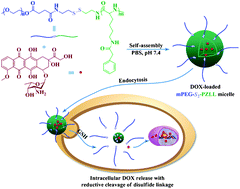The use of antitumour drugs has always been problematic due to the risk of severe side-effects consistent with such cytotoxic compounds. A logical method of reducing side effects is to exercise more control over the deployment of drugs, ensuring that they are only delivered to cancer cells and not across the entire body. The first stage in the development of such a system is the design of biocompatible drug carriers.
Drug carriers must be designed in such a way that they do not interfere with the therapeutic action of the drug yet also be sufficiently resilient that their payload is not released before their cellular destination. A solution to this is to use a chemical trigger that exploits differences in the extracellular and intracellular environments. One such difference is redox potential. Inside the cell, the concentration of the thiol-containing tripeptide glutathione (GSH) is around one order of magnitude higher than it is outside the cell. Disulfides (-S-S-) can be rapidly degraded by GSH meaning that structures that contain them are extremly unstable inside the cell yet remain completely stable in the mildly oxidising conditions found in the extracellular milieu.
Ding et al. prepared micelles consisting of poly(ethylene glycol) (PEG) and poly(ε-benzyloxycarbonyl-L-lysine) (PZLL) linked by a disulfide group. Upon entering the cell, it was envisaged that the fission of the disulfide would greatly undermine the structural integrity of the micelle. The carriers formed were of the order of 100 nm in size and were loaded with the drug Doxorubicon (DOX). In a non-reducing environment more than 50% of the drug was held after sixty hours; in the presence of GSH less than 10% was held demonstrating the effectiveness of the trigger. In vitro efficacy of the micelles was demonstrated using cellular imaging and the biocompatibility of the micelles was found to be extremely high.
J. Mater. Chem. B, 2013, 1, 69. DOI: 10.1039/c2tb00063f
James Serginson is a guest web writer for the Journal of Materials Chemistry blog. He currently works at Imperial College London carrying out research into nanocomposites.
To keep up-to-date with all the latest research, sign-up to our RSS feed or Table of contents alert.











